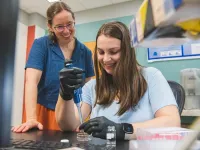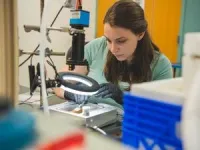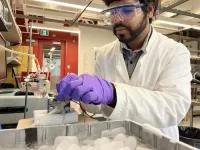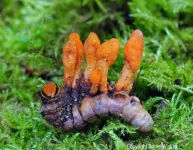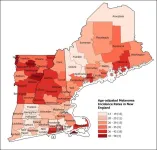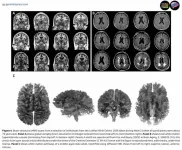(Press-News.org) UNIVERSITY PARK, Pa. — Scientists have spotted microplastics, tiny pieces of plastic smaller than 5 millimeters, in some of the most pristine environments on Earth, from the depths of the Mariana Trench to the snow on Mt. Everest to the mountaintop clouds of China and Japan. Microplastics have been detected in human brains, the bellies of sea turtles and the roots of plants. Now, new research led by Penn State scientists reveals that microplastics in the atmosphere could be affecting weather and climate.
The study, published today (Nov 7) in the journal Environmental Science and Technology: Air, demonstrated that microplastics act as ice nucleating particles, microscopic aerosols that facilitate the formation of ice crystals in clouds.
This means that microplastics could impact precipitation patterns, weather forecasting, climate modeling and even aviation safety by influencing how atmospheric ice crystals form clouds, explained Miriam Freedman, professor of chemistry at Penn State and senior author on the paper.
“Throughout the past two decades of research into microplastics, scientists have been finding that they're everywhere, so this is another piece of that puzzle,” Freedman said. “It’s now clear that we need to have a better understanding of how they're interacting with our climate system, because we’ve been able to show that the process of cloud formation can be triggered by microplastics.”
In the controlled environment of the lab, the researchers studied the freezing activity of four different types of microplastics: low density polyethylene (LDPE), polypropylene (PP), polyvinyl chloride (PVC) and polyethylene terephthalate (PET). The team suspended the four types of plastics in small droplets of water and slowly cooled the droplets to observe how the microplastics affected ice formation.
They found that the average temperature at which the droplets froze was 5-10 degrees warmer than droplets without microplastics. Typically, an atmospheric water droplet without any defects freezes at about negative 38 degrees Celsius, explained Heidi Busse, a graduate student at Penn State and lead author on the paper. Any kind of defect in the water droplet, whether that’s dust, bacteria or microplastics, can give ice something to form — or nucleate — around. That tiny structure is just enough to trigger the water droplet to freeze at warmer temperatures.
“In the case of our microplastics, 50% of the droplets were frozen by minus 22 degrees Celsius for most of the plastics studied,” Busse said. “It turns out that if you introduce something insoluble, you introduce a defect into that droplet and it can nucleate ice at warmer temperatures.”
What this discovery means for weather and climate is not entirely clear, explained Freedman, but it suggests that microplastics are likely already making an impact. She added that mixed-phase clouds, such as the puffy cumulus, blanket-like stratus and dark, ominous nimbus clouds, all contain a combination of liquid and frozen water. These clouds can be widespread throughout the atmosphere, including the classic “anvil” shaped clouds that can form during thunderstorms.
“When air patterns are such that a droplet gets lifted into the atmosphere and cools, that’s when microplastics could be affecting weather patterns and forming ice in clouds,” said Freedman, who is also affiliated with Penn State’s Department of Meteorology and Atmospheric Science. “In a polluted environment with many more aerosol particles, like microplastics, you are distributing the available water among many more aerosol particles, forming smaller droplets around each of those particles. When you have more droplets, you get less rain, but because droplets only rain once they get large enough, you collect more total water in the cloud before the droplets are large enough to fall and, as a result, you get heavier rainfall when it comes.”
In general, clouds cool the Earth by reflecting solar radiation, but certain clouds at certain altitudes can have a warming effect by helping to trap energy emitted from the Earth, Freedman explained. The amount of liquid water versus the amount of ice is important in determining to what extent clouds will have a warming or cooling effect. If microplastics are influencing mixed-phase cloud formation, Freedman said, they are likely affecting climate, too, but it’s extremely difficult to model their overall effect.
“We know that the fact that microplastics can nucleate ice has far-reaching effects, we’re just not quite sure yet what those are,” Busse said. “We can think about this on many different levels, not just in terms of more powerful storms but also through changes in light scattering, which could have a much larger impact on our climate.”
The researchers also found that environmental aging, the natural photochemical processes that aerosol particles experience over time, can significantly change how the particles interact with gases and vapors in the atmosphere. The team simulated environmental aging by exposing the microplastics to light, ozone and acids to see if it changed their ability to form ice.
They found that all the tested plastics could form ice, but aging generally reduced the ice-forming ability of LDPE, PP and PET. In contrast, aging increased the ice-forming ability of PVC due to slight changes on its surface caused by aging.
Next, the team is going to study a variety of additives that are commonly put into plastics, such as plasticizers, to get a better of sense of how commonly used plastics may affect the Earth’s atmosphere.
“We know the full lifecycle of these plastic items we use every day could be changing the physical and optical properties of the Earth’s clouds and, therefore, changing the climate in some way, but we still have a lot to learn about exactly what they are doing,” Busse said.
Other authors on the paper are Devaka Ariyasena and Jessica Orris, graduate students at Penn State. The U.S. National Science Foundation supported this research, which was facilitated by the Materials Characterization Lab at Penn State.
END
Microplastics impact cloud formation, likely affecting weather and climate
2024-11-07
ELSE PRESS RELEASES FROM THIS DATE:
ECOG-ACRIN and PrECOG announce multiple presentations at ASH 2024
2024-11-07
Researchers with the ECOG-ACRIN Cancer Research Group (ECOG-ACRIN) and PrECOG, LLC, will present a variety of abstracts that aim to improve treatments for patients with lymphoma and acute leukemias at the 66th American Society of Hematology (ASH) Meeting & Exposition. The meeting is set to occur in San Diego, California, and virtually December 7 - 10, 2024.
Promising results from a phase 2 study (PrE0905) in patients with acute myeloid leukemia and new data from the practice-changing E1910 phase ...
Off-the-shelf thermoelectric generators can upgrade CO2 into chemicals. The combination could help us colonize Mars
2024-11-07
Readily available thermoelectric generators operating under modest temperature differences can power CO2 conversion, according to a proof-of-concept study by chemists at the University of British Columbia (UBC).
The findings open up the intriguing possibility that the temperature differentials encountered in an array of environments—from a typical geothermal installation on Earth to the cold, desolate surface of Mars—could power the conversion of CO2 into a range of useful fuels and chemicals.
“The environment ...
What makes human culture unique?
2024-11-07
Why is human culture — the shared body of knowledge passed down across generations — so much more powerful than animal cultures?
“What’s special about our species?” is a question scientists have wrestled with for centuries, and now a scientist at Arizona State University has a new hypothesis that could change the way we perceive ourselves, and the world around us.
“Ten years ago it was basically accepted that it was the ability of human culture to accumulate and evolve that made us special, but new discoveries about animal behavior are challenging these ideas and forcing us to rethink what makes our cultures, ...
Researchers discover dozens of new genes associated with disc herniations
2024-11-07
Lumbar disc herniation is one of the most common structural changes in the lower back and the most common cause of radiating pain, or sciatica, in the leg.
Hereditary risk factors for disc herniations were investigated in a recently published international study led by a University of Oulu research group, utilising data from FinnGen, the Estonian Biobank, and the UK Biobank. The study analyzed the genetic and health data of 829,699 participants.
The study found 41 novel regions of the genome that modify the disease risk for disc herniations, in addition ...
Research shows caterpillar fungus can slow down growth of cancer cells
2024-11-07
New research into a chemical produced by a caterpillar fungus that has shown promise as a possible cancer treatment has revealed how it interacts with genes to interrupt cell growth signals. The discovery is an important step towards developing new drugs for the treatment of the disease.
The research into a chemical produced by a caterpillar fungus has revealed how it may work as a cancer treatment. It interrupts the cell growth signals that are overactive in cancer, an approach that could be less damaging to healthy ...
Tanning bed access and usage is driving higher rates of melanoma in specific regions
2024-11-07
Philadelphia, November 7, 2024 – Melanoma accounts for only 1% of skin cancers in the United States but results in the largest number of skin cancer deaths. Investigators evaluated the potential link between the availability and use of tanning beds and the rising rates of melanoma in New England. They found compelling evidence linking tanning bed usage to increased melanoma risk. Their spatial epidemiologic study in the Journal of Investigative Dermatology, published by Elsevier, provides critical insights to inform public health strategies and reduce melanoma incidence.
The incidence of melanoma in the US has been increasing ...
Mitochondrial dysfunction research transforms mental health: Dr. Ana Andreazza's vision
2024-11-07
Toronto, Canada, 7 November 2024 – From a curious young scientist investigating her grandfather's family wine to a leading expert in mitochondrial health and mental illness, Dr. Ana Cristina Andreazza's journey exemplifies the power of personal motivation in driving scientific innovation. As founder and Scientific Director of the Mitochondrial Innovation Initiative (Mito2i), Dr. Andreazza is revolutionizing our understanding of the connection between cellular energy production and mental health.
In an illuminating Genomic Press Interview, published in Brain Medicine on November 7, 2024, ...
Dr. Nora Volkow shares insights on addiction science and harm reduction in Genomic Press interview
2024-11-07
Bethesda, Maryland, USA, 7 November 2024 – Dr. Nora Volkow's mission to revolutionize addiction treatment began with a deeply personal observation: watching how excessive substance use could profoundly alter a person’s behavior while simultaneously triggering social rejection by others. As the first woman and Hispanic Director of the National Institutes of Health’s National Institute on Drug Abuse (NIDA), Dr. Volkow has dedicated her career to investigating how drugs affect the human brain and how these disruptions contribute to the behavioral/emotional ...
25-year study reveals key factors in healthy brain aging and cognitive performance
2024-11-07
Edinburgh, Scotland, 7 November 2024 – A groundbreaking 25-year research program has unveiled key insights into how our brains age and what factors influence cognitive performance throughout life. The findings, published on 7 November 2024 in Genomic Psychiatry, draw from the Lothian Birth Cohorts (LBC) studies, which uniquely tracked participants' cognitive abilities from childhood through their eighth decade of life.
Professor Ian Deary and Dr. Simon Cox from the University of Edinburgh present remarkable discoveries that challenge conventional wisdom about brain aging. Their research ...
First clinical trial reveals promise of psilocybin treatment for anorexia nervosa
2024-11-07
San Diego, California, 7 November 2024 – In a groundbreaking exploration of psychedelic medicine's potential for treating one of psychiatry's most challenging conditions, researchers at University of California, San Diego (UCSD) provided an analysis and further details of a trial published in Nature Medicine (https://pmc.ncbi.nlm.nih.gov/articles/PMC10427429/) that had shown how psilocybin therapy affects individuals with anorexia nervosa. In the new peer-reviewed Emerging Topic article in Psychedelics ...
